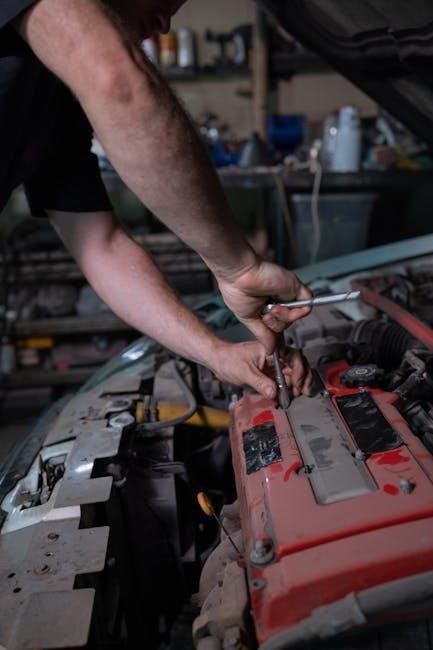The Hayward Aqua Rite Diagnostics Manual provides a comprehensive guide for troubleshooting‚ maintaining‚ and optimizing your Aqua Rite salt chlorination system. Designed for user-friendly navigation‚ this manual covers essential diagnostic procedures‚ error resolution‚ and maintenance tips to ensure peak performance and address common issues effectively.
1.1 Overview of the Hayward Aqua Rite System
The Hayward Aqua Rite system is a cutting-edge salt chlorination solution designed to automatically generate chlorine for pool sanitation. Utilizing advanced salt conversion technology‚ it ensures consistent chlorine levels‚ eliminating the need for manual chlorine additions. The system features a user-friendly interface‚ diagnostic displays‚ and automated functions to maintain optimal pool conditions. Its energy-efficient design and eco-friendly operation make it a popular choice for pool owners seeking reliable and low-maintenance sanitation. This manual serves as a guide to understanding and troubleshooting its components effectively.
1.2 Importance of Diagnostics and Troubleshooting
Regular diagnostics and troubleshooting are essential for maintaining the Hayward Aqua Rite system’s performance and longevity. Identifying issues early prevents system failures‚ ensures consistent chlorine production‚ and reduces maintenance costs. Proper troubleshooting helps resolve errors like low chlorine output or salt level imbalances‚ optimizing pool safety and comfort. This manual provides step-by-step guidance to diagnose and address common problems‚ ensuring your Aqua Rite system operates efficiently and effectively throughout its lifespan.

Diagnostic Displays and Indicators
The Hayward Aqua Rite system features diagnostic displays and indicators‚ including power lights‚ generating light flashing‚ and LCD displays showing HOT or COLD statuses‚ aiding in system monitoring and troubleshooting.
2.1 Understanding Power Light Indications
The power light on your Hayward Aqua Rite system indicates operational status. A steady light means the system is powered on and functioning normally. If the light is off‚ check electrical connections‚ circuit breakers‚ and ensure the power switch is on. Flashing lights may signal specific issues‚ such as low salt levels or internal errors. Always refer to the manual for precise interpretations of power light behaviors to diagnose and resolve issues efficiently.
2.2 Interpreting Generating Light Flashing
The generating light on your Aqua Rite system flashes to indicate various operational statuses. A steady flash may signal normal chlorine production‚ while rapid flashing could indicate a high chlorine demand or system overload. If the light alternates between steady and flashing‚ it might point to a low salt level or cell issues. Refer to the manual for specific flash patterns and their meanings to address system needs promptly and maintain optimal chlorine levels in your pool water.
2.3 Analyzing LCD Displays (HOT or COLD)
The LCD display on your Aqua Rite system shows “HOT” or “COLD” to indicate pool water temperature status. “HOT” signifies high temperatures‚ while “COLD” appears when water drops below 50°F‚ causing the system to stop chlorine generation. Check the temperature sensor for accuracy and ensure proper water flow. If issues persist‚ consult the troubleshooting guide for calibration or maintenance steps to restore optimal system performance and chlorine production.

Troubleshooting Common Issues
This section addresses common problems like low chlorine output‚ high temperatures‚ and system stoppages. It guides users through diagnosing issues and implementing effective solutions to restore functionality.
3.1 No Flow Light On or System Stoppage
The “No Flow” light indicates a system stoppage‚ often due to insufficient water flow. Check for blockages in pipes or valves. Clean or replace the filter if dirty. Ensure the pump is operating correctly. If the issue persists‚ inspect the cell for debris and clean it as needed. Verify that the salt level is within the recommended range. Restart the system after addressing the cause. If the problem recurs‚ consult the manual for further troubleshooting steps or contact a professional for assistance.
3.2 Low Chlorine Residual Causes and Solutions
Low chlorine residual can occur due to improper settings‚ high pool demand‚ or system malfunctions. Check if the Desired Output adjustment is set too low and increase it if necessary; Ensure the salt level is within the recommended range‚ as low salt can reduce chlorine production. Inspect the Turbo Cell for scaling or damage and clean or replace it if needed. Additionally‚ check for sufficient water flow and ensure the system operates continuously during peak usage. Regularly test and adjust chlorine levels to maintain optimal sanitizer performance.
3.3 Salt Level Requirements and Adjustments
Maintaining the correct salt level is crucial for the Aqua Rite system’s efficiency. The recommended salt level ranges between 2‚700 and 3‚700 ppm. Low salt levels can trigger the “Check Salt” indicator and reduce chlorine production. To adjust‚ add pool salt directly to the pool water‚ following the manufacturer’s guidelines. After adding salt‚ run the pump for at least 24 hours to distribute it evenly. Use a salt test strip to confirm the level and ensure it falls within the specified range for optimal system performance and chlorine generation.
Maintenance and System Care
Regular maintenance ensures optimal performance and longevity of the Aqua Rite system. Clean the Turbo Cell‚ inspect salt levels‚ and reset the Inspect Cell LED as needed. Follow manual guidelines for routine care and adjustments.
4.1 Cleaning and Inspecting the Turbo Cell
Cleaning and inspecting the Turbo Cell is crucial for maintaining the Aqua Rite system’s efficiency. Regularly remove mineral buildup and debris to ensure proper chlorine generation. Use a soft brush and mild detergent to clean the cell without damaging its coating. Inspect for any signs of wear or damage and replace the cell if necessary. Proper maintenance prevents reduced performance and extends the lifespan of the system.
4.2 Resetting the Inspect Cell LED
Resetting the Inspect Cell LED on your Aqua Rite system is a simple process. Press and hold the Diagnostics button for 3 to 5 seconds until the LED turns off. This reset is necessary after cleaning or replacing the Turbo Cell‚ ensuring the system accurately monitors salt levels and cell condition. Regular resets help maintain optimal performance and prevent unnecessary alerts. Always refer to the manual for detailed instructions and troubleshooting tips to keep your system running smoothly and efficiently.
4.3 Routine Maintenance Tasks
Routine maintenance is crucial for optimal performance of the Hayward Aqua Rite system. Regularly inspect and clean the Turbo Cell to prevent mineral buildup and ensure efficient chlorine generation. Check salt levels and adjust as needed to maintain the recommended range. Verify proper electrical connections and voltage supply to avoid operational issues. Additionally‚ refer to the manual for specific maintenance intervals and guidelines to keep your system running smoothly and prolong its lifespan. Regular upkeep prevents unexpected failures and ensures consistent pool sanitation.
Advanced Diagnostic Techniques
Advanced diagnostics involve utilizing online troubleshooting resources‚ checking voltage and electrical connections‚ and manually resetting the Aqua Rite system for comprehensive issue resolution.
5.1 Using Online Troubleshooting Resources
Hayward provides extensive online resources for diagnosing and resolving Aqua Rite issues. Visit www.hayward.com or www.HaywardBoardRepairs.com for detailed troubleshooting guides and manuals. These resources offer step-by-step solutions for common problems‚ such as power light issues‚ generating light flashing‚ and salt level adjustments. Online tools also include diagnostic displays‚ error codes‚ and repair instructions‚ ensuring quick and effective resolution of system malfunctions. Utilize these resources to identify and fix issues efficiently‚ ensuring optimal performance of your Aqua Rite system.
5.2 Checking Voltage and Electrical Connections
Ensuring proper voltage and electrical connections is crucial for the Aqua Rite system’s functionality. Verify that the power supply matches the recommended voltage levels specified in the manual. Loose or corroded connections can cause malfunctions‚ so inspect all wires and terminals regularly. Use a multimeter to measure voltage at the control panel and ensure it aligns with the system’s requirements. Addressing electrical issues promptly prevents damage and maintains optimal performance. Always refer to the manual for specific voltage guidelines and safety precautions during inspections.
5.3 Manually Resetting the Aqua Rite System
To manually reset the Aqua Rite system‚ locate the Diagnostics button on the control panel. Press and hold this button for approximately 3 to 5 seconds until the LEDs cycle off. This action resets the system‚ clearing any temporary errors. Ensure the salt level and electrical connections are stable before restarting. If issues persist‚ refer to the manual for detailed instructions or contact an authorized service technician for further assistance. Regular resets can help maintain system efficiency and prevent recurring malfunctions.
Warranty and Service Information
Understand warranty conditions‚ find authorized service centers‚ and access troubleshooting resources for your Aqua Rite system. Visit www.hayward.com for detailed warranty terms and service support options.

6.1 Understanding Warranty Conditions
Understand your Aqua Rite warranty to ensure coverage. Hayward offers specific warranty terms for components like the Turbo Cell and control electronics. Register your product for extended benefits. Warranty periods vary by part‚ with some covering up to five years. Proper installation and maintenance are required to maintain validity. Refer to the manual or Hayward’s website for detailed conditions and exclusions‚ especially for European Union countries‚ to avoid coverage issues.
6.2 Finding Authorized Service Centers
For professional assistance‚ locate authorized Hayward service centers. Visit www.hayward.com or contact customer support for a list of certified technicians. These centers provide genuine parts and ensure warranty compliance. When seeking help‚ confirm the center’s authorization to maintain your system’s performance and warranty validity. Always verify credentials to avoid unauthorized repairs that may void your warranty or compromise your Aqua Rite system’s effectiveness.

Environmental and Safety Considerations
This section emphasizes proper disposal of chlorine generators and safety precautions during maintenance to protect both the environment and users. It outlines guidelines for handling chemicals and equipment safely‚ ensuring eco-friendly operations and compliance with safety standards.
7;1 Proper Disposal of Chlorine Generators
Proper disposal of Hayward Aqua Rite chlorine generators is essential for environmental protection. Ensure all chemicals are safely drained and neutralized. Disconnect electrical components and dispose of them according to local regulations. Recycle metal parts and responsibly handle hazardous materials. Check local guidelines for specific instructions on chlorine generator disposal to minimize ecological impact and comply with environmental laws. Proper disposal prevents contamination and promotes sustainable practices for pool equipment.
7.2 Safety Precautions During Maintenance
Always disconnect power before performing maintenance on the Hayward Aqua Rite system. Wear protective gloves and goggles to avoid exposure to chemicals or electrical components. Ensure the system is cool before handling to prevent burns. Properly ventilate the area to avoid inhaling fumes from chlorine or salt. Follow all manufacturer guidelines for handling chemicals and electrical parts. Never bypass safety features or ignore warning indicators. Regularly inspect cords and connections for damage. Keep children and pets away during maintenance procedures to ensure safety and focus.
This manual empowers users to master Hayward Aqua Rite diagnostics‚ ensuring optimal performance and longevity through effective troubleshooting and routine maintenance.
8.1 Summary of Key Diagnostic Steps
Start by checking the power and generating lights for status indicators. Verify salt levels and inspect the Turbo Cell for cleanliness. Review the LCD display for temperature or error codes. Ensure proper electrical connections and voltage supply. Consult the troubleshooting guide for specific issues‚ such as low chlorine output or system stoppages. Perform routine maintenance tasks‚ like resetting the Inspect Cell LED‚ to maintain optimal performance. Regularly updating your knowledge with online resources ensures you’re equipped to handle any diagnostic scenario effectively.
8.2 Final Tips for Optimal System Performance
For peak performance‚ regularly inspect and clean the Turbo Cell to prevent mineral buildup. Ensure salt levels remain within the recommended range and maintain proper water balance. Check electrical connections and voltage supply to avoid operational issues. Refer to online resources for updated troubleshooting guides and maintenance tips. Schedule routine checks to prevent unexpected system stoppages. By following these steps‚ you can extend the lifespan of your Aqua Rite system and enjoy consistent‚ efficient chlorine generation for your pool.
